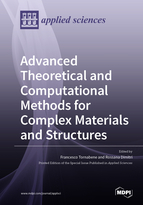Advanced Theoretical and Computational Methods for Complex Materials and Structures
A special issue of Applied Sciences (ISSN 2076-3417). This special issue belongs to the section "Nanotechnology and Applied Nanosciences".
Deadline for manuscript submissions: closed (31 January 2020) | Viewed by 32439
Related Special Issue: Advanced Theoretical and Computational Methods for Complex Materials and Structures (Volume 2)
Special Issue Editors
Interests: theory of shells, plates, arches, and beams; generalized differential quadrature; FEM; SFEM; WFEM; IGA; SFIGA; WFIGA; advanced composite materials; functionally graded materials; nanomaterials and nanotechnology
Special Issues, Collections and Topics in MDPI journals
Interests: damage and fracture mechanics; contact mechanics; structural mechanics; solid mechanics; computational mechanics; advanced composite materials; nanomaterials and nanotechnology
Special Issues, Collections and Topics in MDPI journals
Special Issue Information
Dear Colleagues,
In recent decades, composite materials have been increasingly applied in many engineering applications, e.g., aerospace components, aircrafts, boat hulls and sails, car bodies, long span roofs, as well as biomedical prostheses, electronic devices, and drones. Accordingly, this Special Issue aims at gathering together experts and young researchers in modeling heterogeneous materials and structures at different scales.
Composite materials provide higher values of strength and stiffness, superior thermal properties, and lower levels of weights, which can affect the mechanical behavior of beams, plates, and shells, in terms of static response, vibrations, and buckling loads. Enhanced structures and composite materials feature internal length scales and non-local behaviors, whose responses can be analyzed through parametric investigations, including the effect of staking sequences, ply orientations, the agglomeration of nanoparticles, the volume fractions of constituents, and porosity level.
In addition to fiber-reinforced composites and laminates, studies on innovative components such as functionally graded materials (FGMs), carbon nanotubes (CNTs), graphene nanoplatelets, SMART constituents, as well as innovative and advanced classes of composites are welcomed. Examples of SMART applications involve large stroke SMART actuators, piezoelectric sensors, shape memory alloys, magnetostrictive and electrostrictive materials, as well as auxetic components and angle-tow laminates. These constituents can be included in the lamination schemes of SMART structures to control and monitor the vibrational behavior or the static deflection of several composites.
The development of advanced theoretical and computational models for composite materials and structures is a subject of active research and will be explored for complex systems, including their static, dynamic, and buckling response; fracture mechanics at different scales; as well as the adhesion, cohesion, and delamination of materials and interfaces.
Classical theories, multiscale approaches, cohesive zone modeling of brittle and ductile materials, and the regularization and approximation of crack discontinuities can be presented and discussed to this end. Contributions to theoretical, experimental, and numerical aspects are welcome from scientists working in mathematics and mechanics, involving different industrial applications.
Prof. Dr. Francesco Tornabene
Prof. Dr. Rossana Dimitri
Guest Editors
Manuscript Submission Information
Manuscripts should be submitted online at www.mdpi.com by registering and logging in to this website. Once you are registered, click here to go to the submission form. Manuscripts can be submitted until the deadline. All submissions that pass pre-check are peer-reviewed. Accepted papers will be published continuously in the journal (as soon as accepted) and will be listed together on the special issue website. Research articles, review articles as well as short communications are invited. For planned papers, a title and short abstract (about 100 words) can be sent to the Editorial Office for announcement on this website.
Submitted manuscripts should not have been published previously, nor be under consideration for publication elsewhere (except conference proceedings papers). All manuscripts are thoroughly refereed through a single-blind peer-review process. A guide for authors and other relevant information for submission of manuscripts is available on the Instructions for Authors page. Applied Sciences is an international peer-reviewed open access semimonthly journal published by MDPI.
Please visit the Instructions for Authors page before submitting a manuscript. The Article Processing Charge (APC) for publication in this open access journal is 2400 CHF (Swiss Francs). Submitted papers should be well formatted and use good English. Authors may use MDPI's English editing service prior to publication or during author revisions.
Keywords
- Adhesion
- Advanced computational methods
- Auxetic materials
- Buckling behavior
- Carbon nanotubes
- Complex materials
- Composite beams, plates, and shells
- Constitutive models
- Damage
- Delamination
- Dynamics
- Fracture mechanics
- Functionally graded materials
- Homogenization techniques
- Metamaterials
- Nanostructures
- Smart materials
- Statics
- Theoretical, numerical, and experimental strategies







